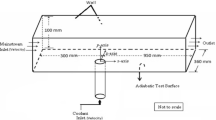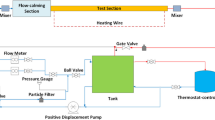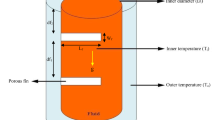Abstract
Experiments were performed in the low-enthalpy AFRL Mach 6 Ludwieg Tube to investigate the effects of surface temperature on hypersonic boundary layer transition. The test article for all experiments was a 7-degree half-angle cone with a sharp nose tip. The model was designed with a large internal cavity, capable of containing pressurized cryogenic fluids. A cooling system utilizing liquid nitrogen was designed and integrated with the test section of the Ludwieg Tube, allowing for significant surface cooling of the test article while maintaining all other conditions, such as tunnel noise spectra. The reduction of the surface temperature to values below 110 K led to a wall-to-boundary layer edge temperature ratio of 1.4, while this ratio was 4.3 for the uncooled case. Boundary layer transition behavior was observed between freestream unit Reynolds numbers ranging from 2.2 million per meter to 25.9 million per meter. Instability waves within the boundary layer were captured via time-resolved Schlieren visualization using a continuous light source. The images confirmed Mack's second mode was present for both uncooled and cooled model experiments. Turbulence intermittency statistics and frequency content of the instabilities were computed via several image processing techniques. Reducing the surface temperature of the test article decreased the boundary layer thickness and subsequently increased the frequency of the most unstable waves. Overall, the cooling delayed the boundary layer transition to turbulence for all cases observed.
Graphical abstract











adapted from Hill (2020)





Similar content being viewed by others
Abbreviations
- \(M_{\infty }\) :
-
Freestream Mach number
- \(P_{{DT}}\) :
-
Initial driver tube pressure
- \(P_{0}\) :
-
Freestream stagnation pressure
- QS:
-
First quasi-steady period of flow
- QS2:
-
Second quasi-steady period of flow
- \(\text{Re} _{\infty }\) :
-
Freestream unit Reynolds number
- \(\text{Re} _{{x\_e,Tr}}\) :
-
Reynolds number at onset of transition, based on boundary layer edge conditions
- \(T_{{DT}}\) :
-
Initial driver tube temperature
- \(T_{0}\) :
-
Freestream stagnation temperature
- \(T_{w} /T_{e}\) :
-
Wall-to-boundary layer edge temperature ratio
- \(U_{\infty }\) :
-
Freestream velocity, m/s
- x:
-
Axial distance along the centerline
- \(\mu _{\infty } {\text{~}}\) :
-
Freestream dynamic viscosity, kg/(m·s)
- \(\rho _{\infty }\) :
-
Freestream density, kg/m3
References
Benitez EK, Jewell JS, Schneider SP (2021) Focused laser differential interferometry with contoured tunnel windows. AIAA J 59(2):419–429. https://doi.org/10.2514/1.J060081
Blanchard AE, Selby GV (1996) An experimental investigation of wall-cooling effects on hypersonic boundary-layer stability in a quiet wind tunnel. In NASA Contractor Report 198287
Cary AM (1968) Turbulent boundary-layer heat transfer and transition measurements for cold-wall conditions at Mach 6. AIAA J 6(5):958–959. https://doi.org/10.2514/3.4646
Casper K, Beresh S, Henfling J, Spillers R, Pruett B (2013) High-speed schlieren imaging of disturbances in a transitional hypersonic boundary layer. 51st AIAA Aerospace Sciences Meeting Including the New Horizons Forum and Aerospace Exposition, January, 1–23. https://doi.org/10.2514/6.2013-376
Chuvakhov PV, Fedorov AV (2016) Spontaneous radiation of sound by instability of a highly cooled hypersonic boundary layer. J Fluid Mech 805:188–206. https://doi.org/10.1017/jfm.2016.560
Demetriades A (1977) Laminar Boundary Layer Stability Measurements at Mach 7 Including Wall Temperature Effects. https://doi.org/10.21236/ADA049535
Duan L, Choudhari MM, Chou A, Munoz F, Radespiel R, Schilden T, Schroder W, Marineau EC, Casper KM, Chaudhry RS, Candler GV, Gray KA, Schneider SP (2019) Characterization of freestream disturbances in conventional hypersonic wind tunnels. J Spacecr Rocket 56(2):357–368. https://doi.org/10.2514/1.A34290
Everhart PE, Hamilton HH (1967) Experimental investigation of boundary-layer transition on a cooled 7.5° total-angle cone at mach 10. NASA TN D-4188. http://ntrs.nasa.gov/archive/nasa/casi.ntrs.nasa.gov/19670029031.pdf
Fedorov A, Soudakov V, Egorov I, Sidorenko A, Gromyko Y, Bountin D, Polivanov P, Maslov A (2015) High-speed boundary-layer stability on a cone with localized wall heating or cooling. AIAA J 53(9):2512–2524. https://doi.org/10.2514/1.J053666
Hameed A, Parziale NJ, Paquin LA, Butler C, Laurence SJ (2020) Hypersonic slender-cone boundary-layer instability in the UMD HyperTERP Shock Tunnel. AIAA Scitech 2020 Forum, January, 1–14. https://doi.org/10.2514/6.2020-0362
Hill JL (2020) Experimental measurements of hypseronic instabilities over ogive-cylinders at Mach 6. Air Force Institute of Technology
Holden M, Wadhams T, MacLean M, Mundy E (2009) Reviews of Studies of Boundary Layer Transition in Hypersonic Flows Over Axisymmetric and Elliptic Cones Conducted in the CUBRC Shock Tunnels. 47th AIAA Aerospace Sciences Meeting Including The New Horizons Forum and Aerospace Exposition, January, 1–17. https://doi.org/10.2514/6.2009-782
Jagde EK, Kennedy RE, Laurence SJ, Jewell JS, Kimmel RL (2019) Visualizations of Boundary-Layer Transition on a Sharp Cone at Mach 6. AIAA Aviation 2019 Forum. https://doi.org/10.2514/6.2019-3080
Jewell JS, Kimmel RL (2017) Boundary-layer stability analysis for stetson’s mach 6 blunt-cone experiments. J Spacecr Rocket 54(1):258–265. https://doi.org/10.2514/1.A33619
Jewell JS, Leyva IA, Shepherd JE (2017) Turbulent spots in hypervelocity flow. Exp Fluids 58(4):32. https://doi.org/10.1007/s00348-017-2317-y
Kara K, Balakumar P, Kandil O (2008) Effects of Wall Cooling on Hypersonic Boundary Layer Receptivity over a Cone. 38th Fluid Dynamics Conference and Exhibit, June, 61–66. https://doi.org/10.2514/6.2008-3734
Kendall JM (1975) Wind tunnel experiments relating to supersonic and hypersonic boundary-layer transition. AIAA J 13(3):290–299. https://doi.org/10.2514/3.49694
Kimmel RL, Adamczak DW, Borg MP, Jewell JS, Juliano TJ, Stanfield SA, Berger KT (2019) First and fifth hypersonic international flight research experimentation’s flight and ground tests. J Spacecr Rocket 56(2):421–431. https://doi.org/10.2514/1.A34287
Kline HL, Chang CL, Li F (2019). Multiple Boundary Layer Instability Modes with Nonequilibrium and Wall Temperature Effects Using LASTRAC. AIAA Aviation 2019 Forum. https://doi.org/10.2514/6.2019-2850
Knisely CP, Zhong X (2019) Significant supersonic modes and the wall temperature effect in hypersonic boundary layers. AIAA J 57(4):1552–1566. https://doi.org/10.2514/1.J057775
Laurence SJ, Wagner A, Hannemann K (2014) Schlieren-based techniques for investigating instability development and transition in a hypersonic boundary layer. Exp Fluids 55(8):1782. https://doi.org/10.1007/s00348-014-1782-9
Laurence SJ, Wagner A, Hannemann K (2016) Experimental study of second-mode instability growth and breakdown in a hypersonic boundary layer using high-speed schlieren visualization. J Fluid Mech 797:471–503. https://doi.org/10.1017/jfm.2016.280
Liang X, Li X, Fu D, Ma Y (2010) Effects of wall temperature on boundary layer stability over a blunt cone at Mach. Comput Fluids 39(2):359–371. https://doi.org/10.1016/j.compfluid.2009.09.015
Mack LM (1984) Boundary-Layer Linear Stability Theory. In AGARD
Marineau EC, Grossir G, Wagner A, Leinemann M, Radespiel R, Tanno H, Chynoweth BC, Schneider SP, Wagnild RM, Casper KM (2019) Analysis of second-mode amplitudes on sharp cones in hypersonic wind tunnels. J Spacecr Rocket 56(2):307–318. https://doi.org/10.2514/1.A34286
Morkovin MV (1969) Critical evaluation of transition from laminar to turbulent shear layers with emphasis on hypersonically travelling bodies. Technical Report AFFDL-TR-68–149.
Moyes AJ, Kocian TS, Mullen D, Reed HL (2018) Boundary-layer stability analysis of HIFiRE-5b flight geometry. J Spacecr Rocket 55(6):1341–1355. https://doi.org/10.2514/1.A34146
Oddo R (2020) High-Speed Schlieren Imaging of Second Mode Disturbances in a Super-Cooled Hypersonic Boundary Layer. Air Force Institute of Technology
Paquin LA, Skinner S, Laurence SJ (2020) Methodology for Investigating the Effects of Wall Cooling on Hypersonic Boundary Layer Transition. https://doi.org/10.2514/6.2020-2962
Richards BE, Stollery JL (1966) Further experiments on transition reversal at hypersonic speeds. AIAA J 4(12):2224–2226. https://doi.org/10.2514/3.3884
Robarge T, Schneider S (2005) Laminar Boundary-Layer Instabilities on Hypersonic Cones: Computations for Benchmark Experiments. 35th AIAA Fluid Dynamics Conference and Exhibit, June. https://doi.org/10.2514/6.2005-5024
Sanator RJ, Decarlo JP, Torrillo DT (1965) Hypersonic boundary-layer transition data for a cold-wall slender cone. AIAA J 3(4):758–760. https://doi.org/10.2514/3.2969
Schneider SP (2004) Hypersonic laminar–turbulent transition on circular cones and scramjet forebodies. Prog Aerosp Sci 40(1–2):1–50. https://doi.org/10.1016/j.paerosci.2003.11.001
Sternberg J (1952) A free-flight investigation of the possibility of high reynolds number supersonic laminar boundary layers. J Aeronaut Sci 19(11):721–733. https://doi.org/10.2514/8.2456
Stetson K, Thompson E, Donaldson J, Siler L (1989). Laminar boundary layer stability experiments on a cone at Mach 8. V - Tests with a cooled model. 20th Fluid Dynamics, Plasma Dynamics and Lasers Conference. https://doi.org/10.2514/6.1989-1895
Van Driest ER (1952) Investigation of laminar boundary layer in compressible fluids using the Crocco method. In NACA Technical Note (Issue 2597). http://naca.central.cranfield.ac.uk/reports/1952/naca-tn-2597.pdf
Acknowledgements
The authors would like to thank Dr. Roger Kimmel of AFRL/RQHF for sponsoring this research and Lieutenant Braeden Sheets for operating the Ludwieg Tube. We also thank Dr. Ross Wagnild of Sandia Laboratories for insightful discussions. Additionally, the authors would like to thank Brian Crabtree and Chris Harkless of the AFIT Model Shop for their outstanding work in fabricating the test article, as well as Michael Ranft of AFIT for providing valuable guidance regarding working with cryogenics. The first six authors would like to acknowledge the support of the Hypersonic Vehicle Simulation Institute and the oversight of Dr. Russ Cummings.
Author information
Authors and Affiliations
Corresponding author
Additional information
Publisher's note
Springer Nature remains neutral with regard to jurisdictional claims in published maps and institutional affiliations.
Rights and permissions
About this article
Cite this article
Oddo, R., Hill, J.L., Reeder, M.F. et al. Effect of surface cooling on second-mode dominated hypersonic boundary layer transition. Exp Fluids 62, 144 (2021). https://doi.org/10.1007/s00348-021-03237-0
Received:
Revised:
Accepted:
Published:
DOI: https://doi.org/10.1007/s00348-021-03237-0




